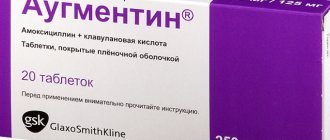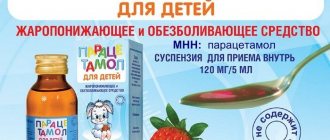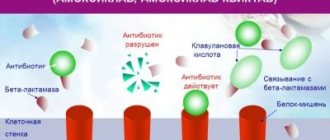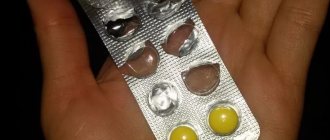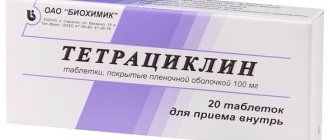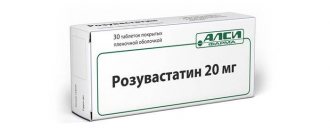Pharmacological group
Indapamide belongs to the pharmacological group of thiazide-like diuretics. In a therapeutic dose, the drug has a hypotensive effect and a slight diuretic effect. When the daily dosage is increased, diuresis increases, but the hypotensive effect does not change. Exceeding the pharmacological dose is considered inappropriate.
Pharmacodynamics
Indapamide is a sulfonylurea derivative – a sulfonamide diuretic. The chemical structure of the drug is similar to thiazide diuretics. Indapamide has a hypotensive effect, affecting the peripheral arteries and kidneys. The drug has a lipophilic structure, penetrates the walls of blood vessels and disrupts the flow of calcium ions into the cells of smooth muscle fibers. This leads to dilation of the arteries and a decrease in peripheral vascular resistance. The vasodilation effect is enhanced by stimulating the synthesis of prostaglandins E2 and prostacyclins I2, which enhance the vasodilatory effect of Indapamide.
At the renal level, the drug reduces the reabsorption in the tubules of water, sodium and chloride ions, and to a lesser extent potassium and magnesium. This leads to an increase in diuresis and a slight decrease in circulating blood volume. The antihypertensive effect helps reduce left ventricular hypertrophy. Taking the drug does not affect fat and carbohydrate metabolism. The drug does not penetrate the blood-brain barrier (BBB), is absorbed through the vessels of the placenta, and accumulates in breast milk.
Pharmacokinetics
When taken orally, Indapamide is completely adsorbed in the digestive tract. Simultaneous food intake slows down absorption, but does not reduce the therapeutic dosage. The peak concentration of the active substance in the peripheral blood is achieved after 2 hours, and the maximum hypotensive effect is achieved after 12 hours, which is associated with the prolonged form of the drug.
Indapamide is 80% bound by transport proteins. Metabolized in the liver. Penetrates into all tissues of the body, except the brain, protected by the BBB. The half-life is 18-24 hours. It leaves the body with urine by 70%, with feces by 30% in the form of metabolites. Less than 7% is excreted unchanged.
How long can you take Indapamide?
How long can you take Indapamide?
Indapamide causes side effects for many, but I’ve been taking it for a year now and feel fine, before that I took Diroton for three years, but then side effects appeared, terrible headaches, a terrible cough, nausea, my blood pressure was 180/120 and then The doctor prescribed Indapamide to me, but I take it in combination with Concor and Cardio Magnyl, i.e. at the same time once a day in the morning, now my blood pressure is 110/90, and I feel great, each medicine is individual for a person.
Indapamide tablets for high blood pressure, my mother takes 1 tablet every day in the morning and for a long time now, the pressure has returned to normal, but the doctor said not to stop taking the tablets. Indapamide can be taken indefinitely and if there are no side effects and you are being monitored by a cardiologist and therapist, then Indapamide can be taken for a long time, but the level of potassium in the body should be monitored.
Indapamide often causes a severe chesty cough. Of course, it relieves blood pressure well, but in almost every second patient with hypertension, these pills cause a cough.
If you do not have such a side effect from them and your blood pressure stabilizes well, then take 1 tablet per day constantly.
My mother and her sister suffer from hypertension and both of them started coughing from these pills six months after they started taking them (they are non-smokers). I had to change them to another medicine, after which the cough stopped by itself.
The mother's blood pressure was 150/90 and she took half a tablet 2 times a day.
And her sister’s blood pressure is slightly higher - 165/100 - she took them 1 tablet 2 times a day. But we must not forget that indapamide is a diuretic and removes potassium from the body.
"Indapamide" is, first of all, a diuretic, that is, a diuretic. Its main purpose is high blood pressure in humans (arterial hypertension, hypertension). The drug is available in tablets or capsules of 2.5 milligrams, and it is recommended to take one tablet (capsule) strictly in the morning.
Like any other diuretic drug, Indapamide negatively affects the acid-base balance, removing potassium from the body. Therefore, the doctor who prescribes it must monitor the content of potassium and sodium in the patient’s blood, and during the treatment process, recommend him food that is a source of potassium (dried apricots, apricots, and so on). Blood tests are carried out at the discretion of the doctor and the patient’s condition - from once a week to once every four weeks.
Take Indapamide for four to eight weeks at first. If it is effective, then it will continue to be prescribed. If the effect is insufficient, then another blood pressure-lowering drug is added. If there are no side effects, then you can take Indapamide for a long time.
It is undesirable for patients with diabetes and pregnant women. There are other contraindications.
Indications for use
For adults
Indapamide is prescribed to lower blood pressure in diseases associated with hypertension.
- Essential hypertension.
- Symptomatic hypertension.
Indapamide is prescribed for hypertension along with other antihypertensive drugs, less often as monotherapy.
For children
The drug is not prescribed to children at any age.
For pregnant women and during lactation
The drug is not prescribed during pregnancy and lactation. Indapamide penetrates the blood-placental barrier into fetal tissue and causes malformations. The drug accumulates in breast milk and can cause toxic effects on the baby's organs. Prescribing the drug during lactation requires stopping breastfeeding. The child is transferred to artificial formula.
Vacation conditions and shelf life
A doctor's prescription is required to purchase the medicine.
The medicine is dispensed in the pharmacy strictly according to the prescription of the treating doctor. The drug can be stored for no more than 2 years, after which its use is strictly prohibited. The production date is indicated on the packaging. The storage room must be protected from access by children and direct sunlight. The temperature in it should not be below 10 degrees and exceed 25 degrees Celsius.
Contraindications
Before using the drug, you must familiarize yourself with the contraindications to prevent the development of complications.
- Intolerance to components in the drug.
- Hypokalemia, hypomagnesemia.
- Renal failure in the stage of decompensation.
- Liver failure in the stage of decompensation.
- Hepatic encephalopathy.
- Pregnancy.
- Lactation period.
- Childhood.
The drug is prescribed with caution in the elderly and senile, especially against the background of insufficient kidney and liver function, gout, and diabetes mellitus.
Water and pressure
Water is the substance that gave life to all living things and has maintained it for many millennia. Water pressure, which is present in the body at the cellular level, is one of the components responsible for human well-being and health. The complex concept of physics “osmotic pressure” is a direct indicator of the state of the body, since it is this pressure that is responsible for metabolic processes taking place at the cellular level in tissues and fluids. A very striking example of such an interaction between solutions of different saturations can be seen in red blood cells and a strong solution of ordinary table salt NaCl - red blood cells, getting into highly salty water, begin to shrink due to the fact that the water from them begins to pass through the cell wall into the solution. If, on the contrary, the salt solution is very, very weak, then the red blood cells swell, become saturated with water, becoming more and more watery until they are completely destroyed. Studies have established that 7.6–8.1 atmospheres is normal for humans, due to both a biologically significant solution of NaCl and other liquids. And the drug “Indapamide”, the instructions for its use stipulate this point, it just allows you to normalize blood pressure by changing the number of salt ions.
Application and dosage
For adults
Indapamide is prescribed 1 tablet (2.5 mg of active substance) once a day, in the morning, regardless of meals. Do not chew the tablet, wash it down with a glass of water for better absorption in the digestive tract. The dose of the drug does not change depending on the use of other antihypertensive drugs as part of combination therapy. A persistent hypotensive effect develops after 1-2 months of treatment. If the therapeutic effect is weak, it is not advisable to increase the dose of the drug, which is associated with the low effect on the hypotensive effect of Indapamide and a significant increase in diuresis.
For children
In childhood, the use of the drug is contraindicated.
For pregnant women and during lactation
During pregnancy and breastfeeding, the use of the drug is contraindicated.
Acripamide
The product is produced in Russia. Acripamide is a diuretic prescribed for hypertension to lower blood pressure. The main substance that has a therapeutic effect is indapamide (as in the drug Indapamide itself).
Don't tolerate high blood pressure
Now hypertension can be cured by restoring blood vessels...
>
Main characteristics:
- Available in tablet form;
- dosage: 2.5 mg of active ingredient;
- group: the medicine is intended to reduce blood pressure in hypertension;
- subgroup: diuretic;
- composition: active ingredient, additional ingredients – glycerin, lactose, talc, potato starch, povidone;
- reception: once a day;
- price: can be purchased in the price range from 35 to 50 rubles.
The effect of the medication is to increase the excretion of chlorine, magnesium and potassium ions (to the least extent) from the liquid. Selectively blocks calcium channels. Increases the elasticity of arterial tissues, reduces vascular resistance. Reduces left ventricular hypotrophy.
Contraindications include liver disease, kidney disease (in the acute phase), allergies to components, age (less than 18 years). The tablets are not recommended for pregnant women. The lactation period is also a contraindication to the use of Acripamide.
Special recommendations: those who take herbal substances or laxatives, as well as elderly patients, are advised to regularly measure the amount of creatinine and potassium ions. If you are diagnosed with diabetes, you should measure your sugar levels more frequently.
When taking the medication, people suffering from ischemia, heart failure or cirrhosis of the liver are advised to undergo regular examination by their doctor in order to reduce the risk of worsening the condition.
We recommend reading: Diuretics for high blood pressure
Side effects
Taking therapeutic doses of Indapamide usually does not cause side effects. The development of undesirable symptoms occurs at the beginning of treatment and goes away on its own within a few days.
- Nausea, less often vomiting.
- Stomach ache.
- Dry mouth.
- Tendency to constipation or diarrhea.
- Nonproductive cough.
- Head pain.
- Sleep disturbance.
- Fast fatiguability.
- Arrhythmias.
- Itchy skin, urticaria.
In the peripheral blood, an increase in the concentration of glucose, uric acid, liver enzymes, hypokalemia, hyponatremia, hypomagnesemia, and hypochloremia can be detected. Diuresis increases, mainly at night.
Side effects
The following side effects sometimes occur when using this medicine:
| Area of possible impact | Phenomena |
| Vessels |
|
| CNS |
|
| Gastrointestinal tract |
|
| Urinary system |
|
| Respiratory system |
|
| Leather |
|
| Hematopoietic system |
|
| Are common |
|
Interaction with other drugs
Concomitant use with potassium-sparing diuretics may lead to disturbances in the level of potassium ions in the blood, especially in patients with renal failure or diabetes mellitus. The interaction of Indapamide with cardiac glycosides enhances the toxic effect of the latter. The drug reduces the therapeutic effect of indirect anticoagulants. Concomitant use of the drug with tricyclic antidepressants, antipsychotics, and ACE inhibitors increases the risk of developing orthostatic hypotension.
There is a high probability of severe hypokalemia when administered simultaneously with glucocorticoids, mineralocorticoids, saluretics, and laxatives. Taking Indapamide and NSAIDs (non-steroidal anti-inflammatory drugs) leads to a decrease in the hypotensive effect. It is not recommended to prescribe the drug and lithium preparations due to the high risk of developing intoxication of the body due to impaired renal function.
Pharmacodynamics and pharmacokinetics
Certificate of Analysis
The effect of the medicine begins to act within half an hour after taking the tablet. In this case, the drug affects the body throughout the day; the period of maximum concentration is important, which is achieved 12 hours after the drug enters the patient’s body. At the end of 18 hours, after the tablet dissolves in the gastrointestinal tract, the time of absorption and half-life of the active substance from the human body begins.
The advice is to eat food to increase the duration of action of Indapamide.
The medication acts as a thiazide diuretic, which, by increasing the amount of sodium excreted in the urine, as well as potassium, chlorine, magnesium and calcium, promotes the elasticity of the walls of blood vessels. This leads to a decrease in blood pressure and has a hypotensive effect on the cardiovascular system and the body as a whole.
special instructions
During treatment with Indapamide, it is necessary to regularly monitor the levels of residual nitrogen, uric acid, glucose, potassium, magnesium, and sodium in the blood. It is recommended to drink enough fluid to replenish water loss with increased diuresis. This prevents the development of dehydration and intoxication of the body. The drug is prescribed with caution to patients with prolongation of the QT interval on the ECG, coronary artery disease, liver cirrhosis, renal failure, and elderly patients who are at risk of developing electrolyte disturbances during treatment.
Reviews
Eremeeva Toma, 28 years old, Inta: “Lately my blood pressure, especially the lower one, has started to bother me. I live in a rather cold area, recently frosts hit forty degrees, this affects the body. I constantly take medications, I started taking one capsule of Indapamide in the morning, which was prescribed by the doctor. My course of treatment is ten days, usually this period is enough to restore the pressure and it does not bother me for a long time.”
Maria Tsareva, 44 years old, Chelyabinsk: “My mother is an experienced hypertensive patient and feels especially bad during the hot seasons of the year. Spring and summer usually cause high blood pressure. Once she reached a hypertensive crisis, after which she regularly uses Indapamide. This remedy helps in cases where the pressure does not exceed 150 to 80; otherwise, you should drink something more effective. I’m especially pleased with the price of the drug.”
Elena, 29 years old, Khabarovsk: “Indapamide is a miracle! I was diagnosed with hydronephrosis, so the doctors prescribed this particular medicine. I took one tablet a day on an empty stomach in the morning for two weeks. At first I lost a little weight, then I underwent examination and it turned out that the treatment was successful. In addition, after undergoing an ECG, tachycardia, which was diagnosed for three years in a row, was not detected. I recommend Indapamide!”
Overdose
Taking recommended therapeutic doses does not cause an overdose. The development of toxic effects occurs when the daily dosage is increased to 40 mg.
- Nausea, vomiting.
- A sharp decrease in blood pressure.
- Depression of breathing and cardiac activity.
- Loss of consciousness and coma.
In case of overdose, gastric lavage is performed, adsorbents (activated carbon) are prescribed, and symptomatic therapy is carried out to restore breathing and cardiac activity. There is no specific antidote.
Instructions for use "Indapamida-Teva"
The drug is taken once a day, preferably in the morning.
The drug, according to the instructions for use, is taken orally. Mostly doctors prescribe its use in the first half of the day. Reception does not depend on food consumption. The daily dose is 2.5 milligrams - one tablet. It is important to take the medication with plenty of clean drinking water. It is permissible to take no more than one tablet per day.
Analogs
You can replace Indapamide with the following components:
- Arifon retard is an original medicine that contains indapamide as an active ingredient. It is produced in tablets with controlled release of the active ingredient. They are used to treat arterial hypertension. Arifon retard should not be used by persons under 18 years of age, pregnant women or those supporting breastfeeding.
- Triplixam is a combination drug that has a diuretic and antihypertensive effect. Its active ingredients are amlodipine, indapamide and perindopril. The drug is recommended for patients suffering from arterial hypertension who are indicated for combination therapy.
- Coperineva contains indapamide and perindopril as therapeutic substances. The drug is available in tablets, which are recommended for the treatment of hypertension in adult patients. Pregnant and breastfeeding women should not take Koperinev's medication.
- In addition to indapamide, Diroton Plus contains lisinopril. The drug is produced in capsules with a modified release of active substances. Diroton Plus can be taken by adult patients who are recommended combination therapy for high blood pressure.
Lorvas SR
Produced in India. This is an analogue of Indapamide and contains the same active ingredient. Actively reduces blood pressure. Refers to non-thiazide diuretics. Main characteristics:
- type: tablets;
- dosage: 1.5 mg of indapamide in each;
- group: the medicine is intended to reduce blood pressure in patients with hypertension (arterial hypertension);
- subgroup: diuretic;
- composition: active ingredient (indapamide) 1.5 mg, additional components – hypromellose, lactose hydrate, starch;
- reception: once a day;
- price: Lorvas SR can be purchased in the price range from 125 to 150 rubles.
The action of Lorvas is aimed at reducing arterial resistance and increasing the elasticity of vascular tissue. Effectively reduces blood pressure and has a moderate diuretic effect.
Contraindications: progressive renal failure, hepatic coma, intolerance to components, hypokalemia. The tablets are not recommended for pregnant women. The lactation period is also a contraindication to the use of Lorvas SR.
Special recommendations: if the recommended dose is exceeded, electrolyte imbalance associated with increased diuresis may occur, or hypokalemia may develop. Cases of gout have been reported. Dizziness may occur during therapy, so special care should be taken when driving a car or complex machinery.
Prevention of hypertension development
Arterial hypertension can be primary and secondary. In both cases, the disease requires strict blood pressure control to prevent its consequences. Hypertension can lead to heart failure, heart attack, and heart enlargement. Aneurysms and enlargements may occur in the vessels, in which blockage often develops. Arterial hypertension is dangerous due to cognitive impairment (decreased performance, intelligence, memory), and the appearance of renal failure. At the same time, a particular threat to health is posed by a combination of harmful factors - a sedentary lifestyle, alcohol abuse, excess weight, diabetes, smoking, unhealthy diet, frequent stress, high cholesterol.
A set of measures aimed at keeping blood pressure within normal limits:
- Low salt diet. Sodium chloride has now been shown to increase blood pressure. Salt intake should be limited to 5 g per day. At the same time, it is worth noting that sodium is concentrated in many products (rye bread, wheat bread, sauerkraut, beans, hard cheeses, sausages, sprats, tuna, seaweed, canned vegetables, mussels, crayfish, flounder). Thus, you should give up the habit of adding salt to ready-made dishes. To enhance their taste, it is recommended to replace sodium chloride with herbs and garlic.
- Physical exercise. Moderate activity in people with mild blood pressure helps improve performance and leads to a noticeable antihypertensive effect. Preferred sports: fast walking, swimming, general development, breathing exercises.
Remember, during intense physical activity, systolic pressure increases sharply. In this connection, you should start exercising little by little, no more than half an hour a day, gradually increasing the load from weak to moderate.
- Quitting alcohol and tobacco. Arterial hypertension, supported by bad habits, is a terrible combination leading to tragic consequences. To prolong the youth of the heart and blood vessels, it is recommended to adhere to the rules of maintaining a healthy lifestyle.
- Limiting animal fats. Fried cutlets, cheeses, sausages, sour cream, butter, and lard are excluded from the diet. Preference is given to low-fat dairy products. This makes it easier to control weight and cholesterol levels, thereby preventing the development of atherosclerosis, heart attack, cerebral stroke, and coronary heart disease.
- Blood pressure (BP) measurement. To track fluctuations in blood pressure, it is mandatory to measure it every day, recording the numbers in a diary, which is subject to strict analysis by the attending physician every 2.5 months.
- Psychological relief. Chronic stress is the main cause of constant blood pressure surges. To bring it back to normal, you need to work on your character, find the positives in everything, and be more tolerant of people. It is useful to master the following methods of psychological relief: meditation, yoga, self-hypnosis, auto-training.
To prevent primary hypertension, it is enough to follow the above methods, while the secondary degree of the disease requires an individual approach in the form of selecting appropriate antihypertensive drugs to systematically maintain blood pressure within normal limits.
Thus, in order to minimize the likelihood of the development and progression of hypertension, you must first review your daily routine, adjust your diet, perform breathing exercises, drink restorative herbal teas, and regularly undergo vitamin therapy.
Remember, by improving your lifestyle, you are improving your body.
Experts' opinions
Indications and contraindications for use are described in the instructions for the drug of the diuretic group “Indapamide”. Reviews from experts about it are also positive, because the drug has been used in the treatment of hypertension and hypertension, eliminating edema for many years, and its effectiveness is considered proven. Yes, experts also note the possibility of developing undesirable effects during treatment with this medicine, but in most cases the drug is well tolerated, and the resulting effect turns out to be what was needed.
As with any other medicine, all relevant information for the diuretic “Indapamide” is provided by the instructions for its use. Properly selected therapy, with an adequately selected drug, regimen and dosage, helps people get rid of hypertension or hypertension, remove swelling, and normalize urination. But it should be remembered that any problems require diagnosis to identify the cause of their occurrence and only then the correct treatment. The drug "Indapamide" can only be prescribed for use by a specialist!
Consequences of hypertension
The leading cause of high mortality among people suffering from cardiovascular (CV) diseases is arterial hypertension, which annually takes the lives of more than 5 million people in the world. The risk group includes smokers, diabetics, women and men over 65 years of age, with high cholesterol levels (from 6.5 mmol/l), as well as a hereditary predisposition to early pathologies of the cardiovascular system.
Remember, hypertension needs to be treated; high blood pressure confines a person to bed, causes malaise, “floaters before the eyes,” shortness of breath, constant dizziness and excruciating pain, which significantly reduce a person’s quality of life. The heart muscle, which works in an intense mode, takes the biggest blow; sooner or later it becomes exhausted, which inevitably leads to a heart attack.
Hypertension violates the integrity of the vascular walls, which causes their destruction, accompanied by hemorrhages. People who do not control their blood pressure and are at risk are susceptible to strokes, which can be prevented with timely treatment.
Currently, complications of hypertension can be avoided through basic modern prevention. It is naive to believe that the diagnosis will go away on its own or disappear completely. The course of the disease can be stopped by continuing to live as usual.
If you ignore the body’s signals, a prolonged increase in blood pressure can cause the following complications in target organs that are most sensitive to its changes:
- nephropathy;
- encephalopathy;
- retinal angiopathy;
- cardiomyopathy, coronary heart disease;
- stroke, heart attack;
- atherosclerosis;
- erectile dysfunction;
- renal failure.
Against the background of hypertension, the likelihood of damage to the atherosclerotic plaque increases, followed by the formation of a blood clot that blocks the arterial vessel, resulting in impaired blood circulation in the brain and heart. To relieve symptoms of the disease and prevent a chain reaction of the body associated with a persistent increase in blood pressure, drug therapy is prescribed using drugs of the following classes: calcium antagonists, angiotensin II receptor blockers and alpha-1-adrenergic receptors, diuretics, ACE inhibitors, beta blockers.
Patient reviews
All the relevant information for the doctor and the common man is contained in the instructions for use about the drug "Indapamide". Reviews from many patients about this medicine for lowering blood pressure, as well as eliminating edema, have a recommendatory connotation, because the drug is well tolerated by many patients, despite the fact that in many cases it is necessary to take it for life.
People also note the affordable price of both tablets and capsules. Yes, long-acting tablets called “Indapamide Retard” are somewhat more expensive, but they do not need to be taken several times a day, but one in the morning is enough. But regular tablets also help lower blood pressure, normalize urination and remove swelling quite effectively, although they have to be taken 2-3 times a day, as prescribed by the attending physician. However, reviews from patients about the medicine can be found quite opposite; some people note that during therapy they experienced some side effects, in particular, a decrease in blood pressure, not higher than 150/80, the pills did not last long enough, and the appearance of headaches. But all the undesirable effects are described only in isolated reviews about the medicine.
Cases of overdose: symptoms, treatment
What happens if you take a large amount of Indapamide? Reviews from doctors say that in such cases the patient experiences nausea, weakness and vomiting. In addition, the patient’s water-electrolyte balance and the functioning of the gastrointestinal tract are disrupted. In some cases, the patient experiences a severe decrease in blood pressure and depressed breathing. In patients with liver cirrhosis, hepatic coma is possible.
How to treat? In case of overdose, the patient should rinse the stomach, adjust the water and electrolyte balance, and apply symptomatic therapy.
Who is the medicine contraindicated for?
Before starting therapy with Indapamide, it is necessary to undergo tests and diagnostics. Despite the safety of the medicine, there is a list of contraindications for use. First of all, tablets are not prescribed to people with hypersensitivity to indapamide or its auxiliary components. Caution in treatment is necessary in the presence of uric acid salts in the joints, in patients with diabetes, arrhythmia, and in elderly patients. Do not take in the following conditions:
- renal and hepatic dysfunctions;
- disturbance of cerebral blood flow;
- lack of sodium or potassium in the blood;
- lack of urination - anuria;
- children and adolescents under 18 years of age;
- period of pregnancy and breastfeeding.
Possible unpleasant consequences
As with any other drug, the instructions for use for Indapamide tablets or capsules describe the potential adverse effects they may cause. It can be:
- agranulocytosis;
- agitation;
- hemolytic anemia;
- anorexia;
- pain in the back or chest;
- arrhythmia;
- hemorrhagic vasculitis;
- vertigo;
- gastralgia;
- hyperglycemia;
- hypercalcemia;
- hypercreatinemia;
- hyperuricemia;
- hypokalemia;
- hyponatremia;
- orthostatic hypotension;
- hypochloremia;
- glucosuria;
- headache;
- dizziness;
- diarrhea;
- constipation;
- itching;
- insomnia;
- cough;
- conjunctivitis;
- hives;
- nocturia;
- pancreatitis;
- paresthesia;
- increased fatigue;
- polyuria;
- sweating;
- vomit;
- rhinitis;
- sinusitis;
- weakness;
- decreased libido and/or potency;
- muscle spasm;
- dry mouth;
- rash;
- nausea;
- anxiety;
- thrombocytopenia;
- pharyngitis.
Also, during therapy with Indapamine, the patient may develop a flu-like syndrome, and systemic lupus erythematosus may worsen. A decrease in body weight may also be observed, and tests may show an increase in urea nitrogen in the blood plasma.
How to take the drug correctly
In order for treatment with Indapamide to be successful, two fundamental principles must be observed when using it:
- Duration. The patient should take into account that the duration of taking the drug is very long. It is possible that you will have to take it for the rest of your life. The effect of treatment begins to appear no earlier than two weeks later.
- Consistency. It is unacceptable to allow breaks in taking the drug. The only reason to stop taking it is if it is canceled by the attending physician. Don't be fooled by the improvement in your condition. Stopping Indapamide may cause your blood pressure to spike. The result is a hypertensive crisis, and in severe cases, a heart attack or stroke.
The daily dose of Indapamide is usually one tablet or 2.5 mg. Eating does not affect its effectiveness in any way. Therefore, you can take the medicine both before and after meals. You need to take it at the same time, preferably in the morning. The tablets must not be chewed. They must be washed down with a sufficient amount of water.
The effectiveness of treatment will be insufficient if you limit yourself to taking Indapamide alone. In order to maintain blood pressure at 135-140/90, it is necessary to take it in combination with other medications (non-diuretics). The doctor decides which medications will be prescribed.
Are there similar medications?
Informs about how the active component in the diuretic drug “Indapamide” works, instructions. Its analogues should have a similar effect - have the ability to enhance the production of urine and promote its quality discharge. You can find a lot of diuretics in pharmacies. As mentioned above, they are divided into three groups. Therefore, many substances work as active components in such medicines. For example, the drug “Veroshpiron” uses spironolactone, and the tablets and injection solution “Lazex” use furosemide.
Many plants have diuretic properties - woolly erva, lingonberry, bearberry, common viburnum and others. It is noteworthy that in most cases, the diuretic properties of such plants are confirmed by official studies, and preparations based on such green diuretics can be purchased in pharmacies.
Provides information that the substance indapamide works in tablets and capsules with the same name - “Indapamide” - instructions for use. Analogues of this medicine that work on this active component have the following names: “Ravel”, “Arifon”, “Indap”, “Retapres”. The doctor decides which drug to purchase to obtain the desired results of therapy.
Indications and contraindications
Doctors prescribe this remedy for the treatment of many diseases associated with liver pathologies. Before you start taking it, you must study the instructions in detail. Often the medicine is prescribed for the following diseases and conditions:
- Intoxication of the body.
- Liver dystrophy.
- Cardiosclerosis.
- Cirrhosis of the liver.
- Heart failure.
- Advanced stage of hepatitis A.
Adverse reactions can develop against the background of individual intolerance and manifest themselves in the form of a rash and a sharp deterioration in well-being. In this case, a person develops headaches, nausea and dizziness. In rare cases, convulsions occur and blood pressure increases.
If a patient experiences bouts of vomiting and diarrhea after taking the pills, then it is worth abandoning this drug and undergoing symptomatic treatment. When an overdose of the drug occurs in a person, hypoglycemia occurs and the composition of the blood changes.
The main reason why you should refuse treatment with this drug is the presence of an allergic reaction to thioctic acid. In addition, the drug is contraindicated in children under six years of age, and in pediatrics it is used only for special indications. Doctors often recommend using more natural and safe medications for babies.
Other contraindications:
- Stomach ulcer.
- Disease of the duodenum.
- Gastritis.
- Diabetes.
A tendency to allergic reactions is a significant reason for refusing treatment.
Pharmacodynamics of Indapamide
Indapamide is the generic name for a synthetic diuretic used to treat high blood pressure. Included in the group of thiazide diuretics. Has a vasodilating effect. Its active ingredient is indapamide hemihydrate.
Indapamide can be used as monotherapy or in combination with other drugs. It is characterized by a dose-dependent effect. At a dose of 2.5 mg, the hypotensive effect is maximum with a slight increase in diuresis. After consuming 2.5 mg of the drug, the maximum effect of lowering blood pressure is observed after 24 hours. With repeated use, the therapeutic effect is observed after 1-2 weeks and reaches a maximum at 8-12 weeks. The substance is considered safe for the human body. There is clinical evidence of the effectiveness of Indapamide in patients with one kidney or on hemodialysis. Toxic effects are observed when using a dose of 40 mg or more.
Clinical observations indicate that regular use of the drug:
- Changes the ability of endothelial cells to pass calcium ions, due to which the elasticity of the walls of blood vessels increases, which reduces the total peripheral vascular resistance (TPVR) to blood flow.
- Effectively reduces high blood pressure levels.
- Leads to a decrease in the volume and mass of the left ventricle.
- Helps remove fluid from the body, which is used to relieve edema.
Correct intake of Indipam tablets
The dosage form is prescribed once a day, regardless of meals. But experts recommend doing this in the morning. If you drink it for two months and there is no improvement, it is not recommended to increase the dosage. It is better to consult a doctor who will prescribe a different course of treatment. If another drug is prescribed at the beginning of treatment, the dosage of this drug is not reduced.
The drug should not be taken by those who have:
- Poor blood circulation in the brain;
- Acute disorders of the liver and kidneys, with a complete cessation of urine flow into the bladder;
- Diabetes mellitus, lack of potassium in the body;
- Pregnancy;
- Hypersensitivity to the constituent components of the product and sulfonamide drugs;
- Lactose intolerance.
There is no information about whether the medicine passes into breast milk. Therefore, it is better not to prescribe Pamid during lactation. If this is still necessary, stop breastfeeding.
During pregnancy, taking the drug can lead to the development of insufficiency of the placental blood supply to the fetus, which will cause its malnutrition.
It is strictly prohibited to prescribe the drug to children and persons under 18 years of age.
Before taking the drug, some laboratory tests are performed. Therefore, taking it on your own is not recommended. The entire treatment course is carried out under the supervision of a doctor to avoid water and electrolyte disturbances in the body.
Pamid can cause the development of a lack of K ions in the blood, which means that it is necessary to constantly conduct laboratory tests and monitor the level of electrolytes. If necessary, the patient is prescribed potassium supplements. A decrease in potassium levels can occur when taking any dose of the drug. This is especially dangerous for patients who have cardiac arrhythmias or who are taking cardiac glycosides. The consequences can be very serious. Therefore, strict monitoring of electrolyte levels is necessary.
This drug is prescribed with caution to patients with impaired renal function, since it is excreted through them. If nitrogenous metabolic products accumulate in the blood, or if urine formation sharply slows down, stop taking it.
The drug Indapamide is prescribed with caution to patients with impaired liver function. Diuretics can lead to a condition in which a lot of acids are lost or accumulated. This may cause the development of hepatic encephalopathy.
Indapamide may cause the patient to experience an increased level of sun sensitivity. Therefore, when such symptoms appear, you need to cover your skin with clothing.
The immediate drop in blood pressure that occurs the moment a person gets out of bed in the morning can be exacerbated by alcohol, drugs, and other blood pressure-lowering medications.
Those with diabetes must monitor their blood glucose levels. Especially in those patients in whom it is below normal.
Sulfonamides, which are contained in the medication, can cause exacerbation of lupus erythematosus.
The prescription of a medicinal product to elderly people is under the supervision of a doctor. An elderly patient will have to undergo tests all the time, keep potassium, magnesium and sodium ions in the blood under control, and control the amount of glucose and uric acid.
In patients undergoing treatment, kidney function is monitored and fluid loss is restored.
It has been established that Indapamide has an effective effect in patients who have one kidney and are on hemodialysis.
Pamid can be taken as monotherapy or in combination with other drugs to normalize blood pressure.
The drug is prescribed for persistent high blood pressure, as well as when edema occurs. The disease is difficult to detect, only by measuring blood pressure.
But there are clinical manifestations that accompany the disease:
- Small flying “spots” in front of the eyes;
- Headache;
- Dizziness.
High blood pressure threatens to cause complications:
- Acute cerebrovascular accident;
- Heart attack;
- The ability to see is impaired;
- Development of heart failure;
- Kidney pathology occurs.
These are very serious consequences, so it is better to take care of your health!
Some features of therapy
Medicines that help remove fluid from the body should be prescribed only when diuretic therapy is necessary. The instructions for the drug Indapamide speak about this approach to treatment. When the pressure exceeds the vital norm for a person of a certain age who has his own diseases, a diuretic helps to normalize fluid excretion and pressure - both cardiac and arterial. But, like many medicines, the drug Indapamide has its own nuances in therapy. Thus, it is not recommended to take it together with lithium preparations, as this can cause poisoning with the chemical element due to a decrease in renal clearance.
Some medications may reduce the hypotensive effect of Indapamide. These are drugs such as vincamine, astemizole, pentamidine, terfenadine, sultopride, quidinine, disopyramide, amiodarone, sotalol and some others. The combination of these drugs can cause aritis. Also, the hypotensive effect of the drug is reduced by non-steroidal anti-inflammatory drugs, tetracosactide, adrenergic stimulants, and glucocorticoids. But baclofen activates it.
The development of hypokalemia can be provoked by saluretics, cardiac glycosides, amphotericin B administered intravenously, tetracosactide, and laxatives. Also, cardiac glycosides taken together with indapamide can provoke digitalis intoxication. If this medicine is used in conjunction with calcium supplements, there is a risk of developing hypercalcemia, and metformin may cause worsening of lactic acidosis.
If the patient has renal artery stenosis, then complex therapy with indapamide and ACE inhibitors is prohibited, since there is a likely risk of developing arterial hypotension and renal failure. The latter problem may also arise when large doses of iodine-containing contrast agents are used to hydrate the body. To use such remedies, the patient must first replenish fluid loss in the body.
Orthostatic hypotension can occur if the drug Indapamide is taken together with tricyclic antidepressants or antipsychotics.
Taking indapamide increases the concentration of blood clotting factors during treatment with indirect coagulants, which adversely affects the effectiveness of the latter.
A blood test may show an increase in creatinine levels when indapamide and cyclosporines are used concomitantly. And the use of muscle relaxants in complex therapy can cause a blockade of neuromuscular transmission.
Any combined use of drugs must be approved by the attending physician. The occurrence of unpleasant consequences of such complex therapy requires changing medications or adjusting the dose and regimen of their use.
Compatibility of Indapamide and alcohol
It's no secret that during therapy using medications it is recommended to refrain from drinking alcohol. Alcoholic drinks can change the properties of drugs, nullifying the result of treatment. However, what to do if the drug is prescribed for a long period? Sometimes lifelong use of Indapamide is required to maintain health. What to do in this case? Start practicing prohibition?
If problems with the cardiovascular system are so serious that a long course of treatment cannot be avoided, it is worth completely eliminating strong drinks from the diet. Otherwise, alcohol can provoke a stroke or heart attack. Another danger posed by this interaction is the deterioration of cardiovascular and cerebral circulation. Thus, the simultaneous intake of alcohol and Indapamide can cause completely different reactions in people: in some - an increased thirst for communication, a feeling of euphoria, restlessness, hyperactivity, hallucinations, in others - absent-mindedness, decreased concentration, lethargy.
The most dangerous consequence of the tandem of strong drinks and medicine is acute heart failure, which can lead to death if emergency medical care is not provided. A negative reaction of the body is accompanied by the following side effects: vomiting, chills, numbness in the legs, severe headache, tingling in the limbs, general weakness, unreasonable fatigue, nervousness, irritability, aching muscles, dry mouth.
Remember, the effect of using Indapamide is cumulative, so even after temporary discontinuation of the drug, the active substance will not disappear from the body. At the same time, the intake of alcoholic beverages poses a serious danger to the patient’s health.
Priorities should be set before undergoing treatment. It is recommended to exclude all factors that may provoke or complicate the process of combating arterial hypertension. A failure in treatment will certainly leave an imprint on general therapy. So before you give in to the temptation to drink a glass of red wine, it’s worth remembering what’s at stake.
When can you drink alcohol if you are taking or have taken the drug?
The medicine is cumulative. Even temporary withdrawal of the drug does not mean that the active substance has been completely eliminated from the body. Taking ethyl alcohol during such a period may complicate treatment.
The effect occurs only 14 days after the start of therapy. How long before you can drink a small glass of wine is a common question.
Drinking alcohol is allowed 20-25 days after taking the last tablet. A long period of abstinence guarantees the preservation of the result and the absence of side effects.
A person must get rid of bad habits before completing the prescribed course. It is important to completely eliminate factors that may interfere with treatment.
This is a remedy that helps normalize blood pressure. A potent medicine in combination with alcohol can lead to toxic poisoning. To preserve the health of internal organs, it is better to refrain from violating the requirements of the instructions.
What works in the medicine?
Diuretic drugs are used in the treatment of many diseases. For the drug “Indapamide Retard 1.5”, the instructions for use, as well as for ordinary tablets “Indapamide”, stipulate as the active component only one substance, by the name of which the drugs are named - indapamide. Its chemical formula is: C16H16ClN3O3S. This substance itself is a white or slightly yellowish powder, crystalline in structure. It dissolves well in aqueous alkaline solutions. The instructions do not provide a more detailed description of the active component of the drugs “Indapamide Retard 1.5” and “Indapamide 2.5”.
How does Indapamide affect the body?
As noted above, Indapamide is a diuretic. Like other diuretics, it has the following properties:
- promotes dilation of blood vessels;
- lowers blood pressure;
- reduces total peripheral vascular resistance;
- increases diuresis;
- reduces the likelihood of hypertrophic cardiomyopathy.
The effect of the drug on the body can be consistently described as follows:
- After taking a diuretic, the volume of urine produced by the kidneys increases.
- Due to the increase in urine volume, urination occurs more frequently.
- Frequent urination leads to dilation of small peripheral renal vessels. The kidneys begin to work better and blockage of blood vessels does not occur.
- The processes described in the previous paragraph lead to the fact that blood pressure begins to gradually decrease. Accordingly, the risk of heart attack or stroke is reduced.
Indapamide spreads throughout the body very quickly. Its maximum concentration in the blood is reached after two hours, or even earlier. The period for its complete removal from the body is up to one and a half days. Two thirds of Indapamide are excreted in the urine, the rest in the feces.
The effectiveness of Indapamide is explained by the fact that it acts on the body faster than other diuretics. In this case, the dose of the drug may be significantly less.
It does not have the ability to negatively affect metabolic processes; it does not affect the levels of glucose, insulin and cholesterol. Thanks to this, Indapamide can be used even for diabetes.
Adverse reactions
When taking the drug Indapamide (we already know what it is prescribed for), a side effect may occur. First of all, this happens when an increased dose of the drug is used, the body is intolerant of the substance, or the effect of individual components on a certain organ system. Side effects can manifest themselves in different ways.
- Central nervous system: headache, drowsiness, asthenia, insomnia, irritability.
- Respiratory system: pharyngitis, acute cough.
- Digestive system: nausea, vomiting, diarrhea.
- Urinary system: nocturia, infectious inflammation.
- Cardiovascular system: arrhythmia, rapid heartbeat, hypokalemia.
- Skin diseases: itching, urticaria, rash.

